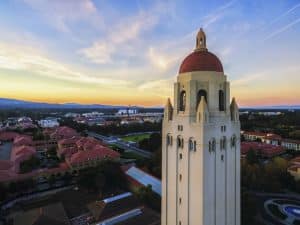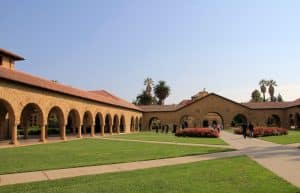Are you a high-achieving student with dreams of attending a top-tier university? Stanford Summer Session might be the key to unlocking your potential and giving you a glimpse of life at one of the world’s most prestigious institutions.
Summer at Stanford Sets You Apart
Stanford Summer Session offers an incredible opportunity to experience a transformative educational journey at a renowned university. This program is not your typical summer break – it’s a chance to balance challenging academics with a rich menu of educational and social activities while being a Stanford visiting student.
You won’t be just another face in the crowd during your time at Stanford. You’ll explore your interests and passions while attending genuine Stanford University courses alongside current Stanford students.
This dynamic, diverse environment brings together students from over 50 countries, providing you with a unique global perspective. What’s more, you can earn credit and receive an official transcript from Stanford, a significant step toward achieving your academic goals.
Attending as a High School Student
If you’re a high school student, the Stanford Summer Session can be your ticket to experiencing an academic quarter at a world-class university. But it’s not for the faint of heart.
To join this community, you should bring solid interpersonal competency, self-directedness, and a genuine commitment to expanding your intellectual horizons.
Tuition & Fees
One important thing to consider is the cost. Stanford University sets tuition and fees for all students. If you plan to commute and take a minimum of three units, costs start at $4,962.
If you prefer the immersive experience of living on campus and taking the minimum eight credit-bearing units (usually 2-3 courses), costs start at $17,197. Investing in your education is significant, but the rewards can be even greater.
Program Dates
Mark your calendar because Stanford Summer Session 2024 will occur from June 22 to August 18. It’s an eight-week journey that can change your perspective and broaden your horizons.
How to Apply
Before you embark on this exciting journey, there are a few eligibility criteria to keep in mind:
- You must be a current sophomore, junior, or senior at the time of application.
- You should be at least 16 at the start of the program on June 24, 2023, and at most 19 by the last day, August 20, 2023. Age restrictions apply, and there are no exceptions to this rule.
- This program is not for first-year Stanford students, so if you’re planning to enroll in Stanford as a first-year student, there may be a better fit for you than the Stanford Summer Session.
Overall, the Stanford Summer Session offers an unparalleled opportunity for high-achieving students to experience the academic excellence, innovation, and global responsibility that Stanford University is known for.
It’s a chance to set yourself apart and take a significant step toward your dreams of getting into your dream college. So, if you meet the eligibility criteria, don’t miss out on this transformative experience – apply and discover your potential with the Stanford Summer Session.
Stanford Summer Session Application: A Step-by-Step Guide
If you’re considering applying for the Stanford Summer Session, you’re on the right path to an exciting academic adventure. But before jumping in, let’s break down the application requirements simply.
1. Transcripts
Your transcripts are like your academic report card. They should include your full name and your school’s name. Ensure they show your latest grades, especially the ones from your most recent semester.
If you’ve been a part of a previous Summer Session, remember to include those grades, too. The best part? Your transcripts don’t have to be official. If you’re an international student, ensure your transcripts are in English, and explain the grading scale from your country.
2. Two Short Essays
These essays are a chance to introduce yourself beyond your grades and courses. It’s not about fancy words; it’s about showing who you are. Write a short paragraph for each short answer question that tells the reader more about you and shows your writing skills. Now, let’s look at the essay topics:
a. Reflect on a Grateful Moment
Write about something that someone did for you that made you really happy or thankful, even if it was surprising. Share how this experience made you feel and how it motivated or influenced you.
b. Showcase Your Strength or Quality
Think about a special strength or quality you possess that you believe others should recognize. Explain why this is important, and how it can benefit the community.
c. Choose Your Ideal Conversation Partner
Imagine having an hour-long chat with a historical figure, a fictional character, or a modern individual. Who would you choose and why? What would you discuss?
3. Another Reflective Essay
You’ll need to respond to one of the following questions in 250-300 words:
a. Share a Personal Experience
Think about an experience in your life that had a significant impact on who you are today. Describe the experience and how it has shaped your perspective on life.
b. Explore a New Culture or Belief System
Share an experience where you were exposed to a new culture or belief system. Explain how this experience broadened your understanding of the world.
c. Handle a Difficult Conversation
Reflect on a situation where you had a challenging conversation with someone who had opposing views. Describe your approach to this dialogue and the lessons you learned, that you can apply during the Summer Session.
4. Proof of English Proficiency (If Needed)
If English isn’t your native language, you might need to show your proficiency in English. No need for standardized test scores. Instead, you can submit iBT TOEFL, IELTS: Academic, Cambridge Exam, Duolingo, or PTEA Scores. Just make sure to upload scores with your name within the application.
That’s it! The Stanford Summer Session application is your gateway to a unique educational experience. Keep your documents in order, be yourself in your essays, and embrace the opportunity to learn and grow. Good luck with your application!
Stanford Summer Session Experience: Housing, Dining, and More
Stanford Summer Session is an eight-week journey of learning and exploration, and where you choose to live can significantly shape your experience. Let’s break down your options in simple terms.
Live on Campus: Limited Space, Apply Early
If you’re considering living on campus, remember that residential space is limited. That’s why it’s a smart move to apply early. On campus, you’ll be part of a vibrant community led by Stanford undergraduate students and Residential Experience professionals. These Summer Resident Assistants and House Directors are here to provide guidance supervision, and plan social and extracurricular activities that support your growth in the residence.
Housing
You’ll stay in a classic undergraduate residence hall. These buildings come with all the essentials, including a lounge, common area, laundry facility, and a computer cluster with a printer. You’ll have a roommate, and you might find yourself on co-ed floors. It’s all part of the experience!
Dining
Meals at Stanford are a chance to connect with your fellow students in a nearby dining commons. The menu offers a variety of nutritious, sustainable, and delicious food choices. If you have special dietary needs like food allergies, religious requirements, or medical needs, or follow a vegan/vegetarian diet, don’t worry; dining options are designed to support you.
Academics
You’ll be taking your classes on campus, where you’ll join a diverse community of students and staff from all corners of the world. This mix of backgrounds, cultures, and experiences creates a vibrant learning environment.
Live Nearby? Commute to Class
If you live nearby, you can attend Summer Session as a commuter student. You’ll still have access to the same on-campus facilities, from libraries to health and wellness centers.
Plus, you can participate in programming that connects you to a larger Bay Area network of students. Dedicated staff are there to support the specific needs of commuter students.
Resources: Support and Minimum Units
Residential students must take a minimum of 8 units, which typically means two to three courses. However, residential graduate students can take fewer than 8 units as long as they don’t require an I-20 from Stanford. For commuter students, the minimum is 3 units, which translates to one course. But keep in mind that all students must take a minimum of 8 units if they require an I-20 from Stanford.
So, whether you choose to live on campus or commute, your Stanford Summer Session experience is all about learning, growth, and connecting with a diverse and exciting community. Decide what suits you best, and embark on your eight-week journey with confidence!
Stanford Summer Session Courses
At Stanford, the Summer Session is more than just a break from regular classes; it’s a chance to dig into courses that count towards your Stanford University credit. You’ll find various options spanning over 30 departments, from foundational core courses to Stanford’s unique offerings.
The beauty of Stanford Summer Session lies in its diversity of courses. Whether exploring familiar subjects or venturing into uncharted territory, our extensive range has something for everyone. Rest assured, the Academic Support team is by your side every step of the way.
Navigating the Summer Quarter Workload
Keep in mind that during the Summer Quarter, the programs compress the typical 10-week term into a brisk eight weeks. This means course load requirements rise accordingly. Each credit you earn represents roughly three hours of work per week for the average student.
However, your workload depends on your specific course selection and personal circumstances. Don’t fret; their advising team is there to guide you and help you gauge the estimated workload for your preferred courses, including any prerequisites.
Sample Courses
Here are a few sample courses to give you a glimpse of what’s in store:
1. Implicit Bias (ANTHRO 145S)
Course Cost: $3,846.00
Audience: High School, Undergraduate
This class delves into the realms of psychology and sociology, seeking answers to fundamental questions: What is race, and what is racism? The journey also explores the complex concept of implicit bias, equipping students to understand, recognize, and critically evaluate it.
Early colonial theories of scientific racism, enduring myths about race and intelligence, and topics like phrenology, eugenics, and stereotype threat are all on the syllabus. This course will challenge you to understand how race can simultaneously lack an evolutionary or biological foundation yet drive many social and political dynamics.
The persistence of stereotypes, implicit bias, microaggression, and institutional racism will also be scrutinized, leaving students with a profound understanding of how prejudice has shaped our world. You’ll discover that diverse approaches to understanding implicit bias profoundly affect social policy and justice.
2. Intro to Cultural and Social Anthropology (ANTHRO 1S)
Course Cost: $3,846.00
Audience: High School, Undergraduate
This course introduces fundamental anthropological concepts, providing insights into the discipline’s unique perspective on society and culture. You’ll explore ethnographic cases that vividly illustrate how anthropological methods shed light on contemporary social and political issues across diverse cultural settings.
3. Painting and Collage (ARTSTUDI 145S)
Course Cost: $3,846.00
Audience: High School, Undergraduate
This introductory class takes you on an artistic journey, combining painting and collage techniques to expand your visual language. Traditional painting methods meld with the prefabricated nature of collage, creating an aesthetic harmony that produces sensations of volume, space, movement, and light on a flat canvas.
Dive into collage materials from magazines, newspapers, old books, cloth, and found objects, interplaying them with acrylic paint applications.
These sample courses merely scratch the surface of what Stanford Summer Session offers. So, embrace the diversity, explore your academic interests, and embark on a transformative journey through our courses.
4. Cell Phone Photography (ARTSTUDI 173S)
Course Cost: $3,846.00
Audience: High School, Undergraduate
This course critically examines cell phone photography while encouraging students to create photographic artworks that explore this specific medium’s experimental, social, and documentary potential.
Cell phone photography has revolutionized art by democratizing image-making through platforms like Instagram and Snapchat, transforming notions of authorship and subjectivity. The course also explores how new technological tools expand creativity and aesthetic standards.
5. Microbiology: Human Health & Society (BIO 11S)
Course Cost: $6,410.00
Audience: High School, Undergraduate
This course delves into microbes, covering bacteria, archaea, fungi, viruses, and more. Discover how these tiny organisms impact human health and society, both positively and negatively.
Explore microbiology through the lenses of molecular genetics, biochemistry, immunology, and biotechnology. The course also provides hands-on laboratory experience, allowing students to work with bacteria and small eukaryotes.
6. Introduction to Biotechnology: Detecting and Treating Disease (BIO 32S)
Course Cost: $3,846.00
Audience: High School, Undergraduate, Graduate
This course explores the foundations of biotechnology and the techniques used to manipulate nucleic acids (DNA and RNA). Dive into the world of disease detection and treatment, with a special focus on tools for identifying viral infections like COVID-19.
The course also delves into ethical and privacy issues related to biotechnology, including genetic testing, vaccine distribution, and gene therapy.
7. Introduction to Cancer Biology (BIO 50S)
Course Cost: $3,846.00
Audience: High School, Undergraduate, Graduate
Cancer biology is a field that’s both challenging and impactful. This course dissects the biological processes disrupted in cancer, from DNA repair to cell cycle control and signaling pathways.
Students will gain insight into the molecular mechanisms behind tumor growth and learn about potential therapeutic targets. The course also covers cancer prevention, diagnosis, and treatment, including emerging topics like cancer stem cells.
8. Introduction to Human Physiology (BIO 8S)
Course Cost: $5,128.00
Audience: High School, Undergraduate
This course delves into the normal functioning and pathophysiology of major organ systems, including the nervous, respiratory, cardiovascular, renal, digestive, and endocrine systems.
You’ll explore integrative physiology, clinical case studies, and the applications of genomics-based personalized medicine. Understand the intricate workings of the human body and its physiological processes.
9. Sustainability Design Thinking (CEE 176G)
Course Cost: $3,846.00
Audience: High School, Undergraduate, Graduate
Unleash your creativity and apply design thinking to make sustainability not just a concept but a compelling and realizable reality. Dive into contextual, functional, and human-centered design thinking techniques to promote sustainable design in products and environments.
This holistic approach considers space, form, environment, energy, economics, and health. Engage in studio project work involving prototyping, modeling, testing, and realizing sustainable design ideas.
10. Accelerated First-Year Chinese, Part 1 (CHINLANG 1A)
Course Cost: $6,410.00
Audience: High School, Undergraduate, Graduate
Designed for students without prior knowledge of the Chinese language, this course aims to develop communicative competence in listening, speaking, reading, and writing skills at the elementary level. Embark on a journey to explore the beauty and complexity of the Chinese language.
11. Greek and Latin Roots of English (CLASSICS 14)
Course Cost: $3,846.00
Audience: High School, Undergraduate, Graduate
Enhance your vocabulary, comprehension of written English, and standardized test scores by unraveling the Greek and Latin components of the English language. Delve into the patterns and processes that shape the English lexicon.
You’ll gain insight into terminology in various fields, from medicine and business to education, law, and the humanities. And the best part? You don’t need prior knowledge of Greek or Latin.
12. Greek Mythology (CLASSICS 31)
Course Cost: $6,410.00
Audience: High School, Undergraduate, Graduate
Dive into the world of ancient Greece and explore the heroic and divine elements in its literature, mythology, and culture.
This course takes an interdisciplinary approach to studying individuals and society, offering illustrated lectures and readings in translation from authors like Homer, Hesiod, Herodotus, and the poets of lyric and tragedy.
The course also provides different work requirements based on your chosen unit level.
13. Digital Media and Personalization (COMM 103S)
Course Cost: $3,846.00
Audience: High School, Undergraduate
In the age of personalization technologies, the digital landscape is transformed. This course unravels the societal impact of personalization technologies, which have disrupted domains from politics to fashion.
By analyzing the data trail left by users on digital media platforms, we can peer into their minds and infer their psychological characteristics.
These inferences are then used to customize messages to individual users, aiming to create a psychological fit that maximizes persuasive appeal. The course delves into the psychological mechanisms underpinning personalization technologies, the role of big data and machine learning, and the ethical issues arising from their rise.
It combines an extensive data perspective with socio-cognitive psychological research to understand how and why personalization technologies work and their broader societal implications.
Stanford Admission Criteria: What Matters
The Stanford Summer Session admission process is a glimpse into your identity and values. This comprehensive approach integrates each application element to create a holistic overview.
Academic Excellence
Your transcript and school report are windows into your school and academic accomplishments. The pivotal requirement for Stanford Summer Session admission is academic excellence. They seek signs of your readiness and potential for success.
They anticipate you’ve pushed your boundaries throughout high school and achieved commendably. Your high school transcript is the most critical element in assessing your academic history.
It’s worth noting that the admissions office’s evaluation surpasses any mere numerical assessment. No specific GPA threshold or a set count of AP or honors courses on your transcript is mandated for your application’s consideration or acceptance.
Intellectual Curiosity
Your essays provide insights into your ideas, passions, and what holds significance for you. They aspire to witness your dedication, commitment, and genuine enthusiasm for broadening your intellectual horizons, both in your self-expression and the courses you’ve undertaken.
Final Thoughts
The Stanford Summer Session is a dynamic and enriching experience that offers a blend of academic rigor, personal development, and lifelong learning. Whether you’re a high school student eager to get a taste of college life, an undergrad looking to fast-track your degree, or a professional aiming to upskill, Stanford’s Summer Session has something to offer you. It’s not just an education—it’s a transformative experience.
With a diverse range of courses, excellent campus facilities, and an array of summer activities and events, your summer at Stanford will be an unforgettable experience. So, why not take the leap and explore Stanford this summer?
It is important to have all the necessary information before making any decision. AdmissionSight is always here to help you with any questions or concerns. We have over ten years of experience helping students successfully navigate the challenging admissions process.
Consult with AdmissionSight and find out how we can help you get into the school of your choice by ensuring that you are fully informed and prepared for the application process. We will work with you to develop a personalized plan that meets your specific needs and goals. We will also provide you with access to our team of experts who can help you with everything from choosing the right schools to writing your essays.
Don’t let the admissions process overwhelm you. Contact AdmissionSight today and let us help you achieve your dreams.











































